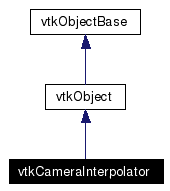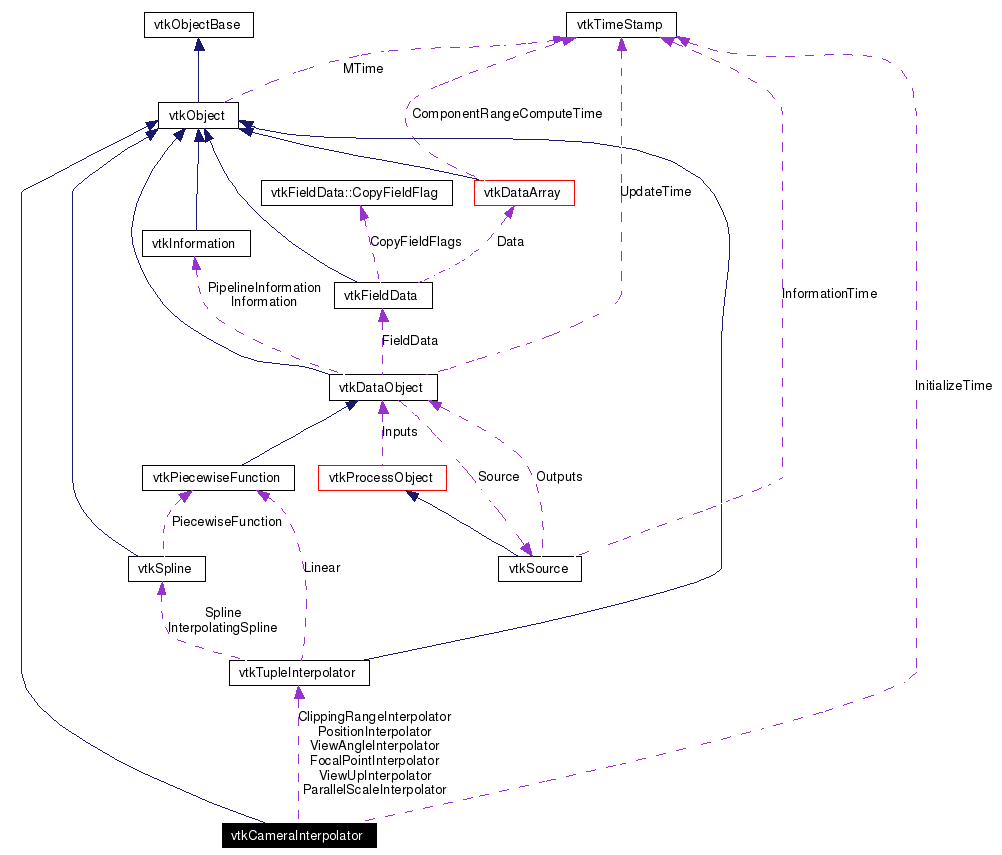vtkCameraInterpolator Class Reference
#include <vtkCameraInterpolator.h>
Inheritance diagram for vtkCameraInterpolator:
 [legend]Collaboration diagram for vtkCameraInterpolator:
[legend]Collaboration diagram for vtkCameraInterpolator: [legend]List of all members.
[legend]List of all members.
Detailed Description
interpolate a series of cameras to update a new camera
This class is used to interpolate a series of cameras to update a specified camera. Either linear interpolation or spline interpolation may be used. The instance variables currently interpolated include position, focal point, view up, view angle, parallel scale, and clipping range.
To use this class, specify the type of interpolation to use, and add a series of cameras at various times "t" to the list of cameras from which to interpolate. Then to interpolate in between cameras, simply invoke the function InterpolateCamera(t,camera) where "camera" is the camera to be updated with interpolated values. Note that "t" should be in the range (min,max) times specified with the AddCamera() method. If outside this range, the interpolation is clamped. This class copies the camera information (as compared to referencing the cameras) so you do not need to keep separate instances of the camera around for each camera added to the list of cameras to interpolate.
- Warning:
- The interpolator classes are initialized the first time InterpolateCamera() is called. Any later changes to the interpolators, or additions to the list of cameras to be interpolated, causes a reinitialization of the interpolators the next time InterpolateCamera() is invoked. Thus the best performance is obtained by 1) configuring the interpolators, 2) adding all the cameras, and 3) finally performing interpolation.
Currently position, focal point and view up are interpolated to define the orientation of the camera. Quaternion interpolation may be added in the future as an alternative interpolation method for camera orientation.
- Tests:
- vtkCameraInterpolator (Tests)
Definition at line 62 of file vtkCameraInterpolator.h.
Member Typedef Documentation
Member Enumeration Documentation
|
|
Enums to control the type of interpolation to use. - Enumerator:
-
| INTERPOLATION_TYPE_LINEAR |
|
| INTERPOLATION_TYPE_SPLINE |
|
| INTERPOLATION_TYPE_MANUAL |
|
Definition at line 102 of file vtkCameraInterpolator.h. |
Constructor & Destructor Documentation
| vtkCameraInterpolator::vtkCameraInterpolator |
( |
|
) |
[protected] |
|
| virtual vtkCameraInterpolator::~vtkCameraInterpolator |
( |
|
) |
[protected, virtual] |
|
Member Function Documentation
| virtual const char* vtkCameraInterpolator::GetClassName |
( |
|
) |
[virtual] |
|
| static int vtkCameraInterpolator::IsTypeOf |
( |
const char * |
type |
) |
[static] |
|
|
|
Return 1 if this class type is the same type of (or a subclass of) the named class. Returns 0 otherwise. This method works in combination with vtkTypeRevisionMacro found in vtkSetGet.h.
Reimplemented from vtkObject. |
| virtual int vtkCameraInterpolator::IsA |
( |
const char * |
type |
) |
[virtual] |
|
|
|
Return 1 if this class is the same type of (or a subclass of) the named class. Returns 0 otherwise. This method works in combination with vtkTypeRevisionMacro found in vtkSetGet.h.
Reimplemented from vtkObject. |
| void vtkCameraInterpolator::PrintSelf |
( |
ostream & |
os, |
|
|
vtkIndent |
indent |
|
) |
[virtual] |
|
|
|
Methods invoked by print to print information about the object including superclasses. Typically not called by the user (use Print() instead) but used in the hierarchical print process to combine the output of several classes.
Reimplemented from vtkObject. |
|
|
Instantiate the class.
Reimplemented from vtkObject. |
| int vtkCameraInterpolator::GetNumberOfCameras |
( |
|
) |
|
|
|
|
Return the number of cameras in the list of cameras. |
| double vtkCameraInterpolator::GetMinimumT |
( |
|
) |
|
|
|
|
Obtain some information about the interpolation range. The numbers returned are undefined if the list of cameras is empty. |
| double vtkCameraInterpolator::GetMaximumT |
( |
|
) |
|
|
|
|
Return the number of cameras in the list of cameras. |
| void vtkCameraInterpolator::Initialize |
( |
|
) |
|
|
|
|
Clear the list of cameras. |
| void vtkCameraInterpolator::AddCamera |
( |
double |
t, |
|
|
vtkCamera * |
camera |
|
) |
|
|
|
|
Add another camera to the list of cameras defining the camera function. Note that using the same time t value more than once replaces the previous camera value at t. At least one camera must be added to define a function. |
| void vtkCameraInterpolator::RemoveCamera |
( |
double |
t |
) |
|
|
|
|
Delete the camera at a particular parameter t. If there is no camera defined at location t, then the method does nothing. |
| void vtkCameraInterpolator::InterpolateCamera |
( |
double |
t, |
|
|
vtkCamera * |
camera |
|
) |
|
|
|
|
Interpolate the list of cameras and determine a new camera (i.e., fill in the camera provided). If t is outside the range of (min,max) values, then t is clamped to lie within this range. |
| virtual void vtkCameraInterpolator::SetInterpolationType |
( |
int |
|
) |
[virtual] |
|
|
|
These are convenience methods to switch between linear and spline interpolation. The methods simply forward the request for linear or spline interpolation to the instance variable interpolators (i.e., position, focal point, clipping range, orientation, etc.) interpolators. Note that if the InterpolationType is set to "Manual", then the interpolators are expected to be directly manipulated and this class does not forward the request for interpolation type to its interpolators. |
| virtual int vtkCameraInterpolator::GetInterpolationType |
( |
|
) |
[virtual] |
|
|
|
These are convenience methods to switch between linear and spline interpolation. The methods simply forward the request for linear or spline interpolation to the instance variable interpolators (i.e., position, focal point, clipping range, orientation, etc.) interpolators. Note that if the InterpolationType is set to "Manual", then the interpolators are expected to be directly manipulated and this class does not forward the request for interpolation type to its interpolators. |
| void vtkCameraInterpolator::SetInterpolationTypeToLinear |
( |
|
) |
[inline] |
|
|
|
These are convenience methods to switch between linear and spline interpolation. The methods simply forward the request for linear or spline interpolation to the instance variable interpolators (i.e., position, focal point, clipping range, orientation, etc.) interpolators. Note that if the InterpolationType is set to "Manual", then the interpolators are expected to be directly manipulated and this class does not forward the request for interpolation type to its interpolators.
Definition at line 121 of file vtkCameraInterpolator.h. |
| void vtkCameraInterpolator::SetInterpolationTypeToSpline |
( |
|
) |
[inline] |
|
|
|
These are convenience methods to switch between linear and spline interpolation. The methods simply forward the request for linear or spline interpolation to the instance variable interpolators (i.e., position, focal point, clipping range, orientation, etc.) interpolators. Note that if the InterpolationType is set to "Manual", then the interpolators are expected to be directly manipulated and this class does not forward the request for interpolation type to its interpolators.
Definition at line 123 of file vtkCameraInterpolator.h. |
| void vtkCameraInterpolator::SetInterpolationTypeToManual |
( |
|
) |
[inline] |
|
|
|
These are convenience methods to switch between linear and spline interpolation. The methods simply forward the request for linear or spline interpolation to the instance variable interpolators (i.e., position, focal point, clipping range, orientation, etc.) interpolators. Note that if the InterpolationType is set to "Manual", then the interpolators are expected to be directly manipulated and this class does not forward the request for interpolation type to its interpolators.
Definition at line 125 of file vtkCameraInterpolator.h. |
|
|
Set/Get the tuple interpolator used to interpolate the position portion of the camera. Note that you can modify the behavior of the interpolator (linear vs spline interpolation; change spline basis) by manipulating the interpolator instances directly. |
|
|
Set/Get the tuple interpolator used to interpolate the position portion of the camera. Note that you can modify the behavior of the interpolator (linear vs spline interpolation; change spline basis) by manipulating the interpolator instances directly. |
| virtual void vtkCameraInterpolator::SetParallelScaleInterpolator |
( |
vtkTupleInterpolator * |
|
) |
[virtual] |
|
| virtual void vtkCameraInterpolator::SetClippingRangeInterpolator |
( |
vtkTupleInterpolator * |
|
) |
[virtual] |
|
| unsigned long vtkCameraInterpolator::GetMTime |
( |
|
) |
[virtual] |
|
|
|
Override GetMTime() because we depend on the interpolators which may be modified outside of this class.
Reimplemented from vtkObject. |
| void vtkCameraInterpolator::InitializeInterpolation |
( |
|
) |
[protected] |
|
Member Data Documentation
The documentation for this class was generated from the following file:
Generated on Mon Jan 21 23:36:31 2008 for VTK by
 1.4.3-20050530
1.4.3-20050530



 1.4.3-20050530
1.4.3-20050530